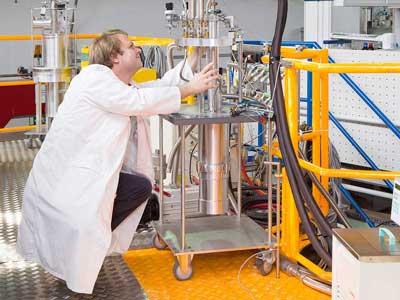| Dec 07, 2018 | |
Fast storage material in neutron light(Nanowerk News) Novel phase change memory (PCM) materials can work a thousand times faster than current flash memory chips, while being significantly more durable. Using the research neutron source of the Technical University of Munich (TUM), German and American researchers have gained important insights into this promising domain. |
|
| Phase change memories store data by altering the state of the matter of the individual bits between liquid like glassy and crystal states. An electromagnetic field, heat or light pulses switch between the phases. The technology has the potential to provide inexpensive, high-speed, high-density storage. | |
| Corporations such as Intel, IBM and Samsung have thus been trying to implement the principle of phase change memories for a long time in technically usable products. There is still a lack of clarity on how the material manages the phase changes on such short time scales and how to control the changes with necessary precision. | |
A thousand times faster and yet more stable |
|
| Now, a team of scientists from Arizona State University, RWTH Aachen University, the University of Saarland and the Technical University of Munich describes how an alloy of germanium, antimony and tellurium could work a thousand times faster than current flash memory. | |
| At the same time, the memory can be read much more frequently. They found that this special mixture allowed the phase changes to be delimited more sharply and controlled more reproducibly than using other materials investigated so far. | |
Glassy solid liquid |
|
| In their work (Science Advances, "Breakdown of the Stokes-Einstein relation above the melting temperature in a liquid phase-change material"), the scientists headed by Dr. Shuai Wei (RWTH) and Dr. Zachary Evenson (TUM) investigated the alloy in its glassy-liquid state by way of neutron scattering at the Heinz Maier-Leibnitz Center in Garching. | |
| "The high resolution and high flux of the neutron time-of-flight spectrometer at the Technical University of Munich FRM II neutron source was necessary to see the details of the atomic movements,” Dr. Zachary Evenson, who was an instrument scientist at TUM at the time. | |
 |
|
| Dr. Zachary Evenson at the TOFTOF time-of-flight spectrometer at the FRM II. (Image: S. Mast / TUM) | |
Contradicting Einstein |
|
| The researchers believe that mixing germanium, antimony, and tellurium in a specific ratio will cause both the density maxima and the associated metal-to-metal transitions to occur below the melting point, making the transition much more distinct than in other such compounds. | |
| In fact, they even show that an equation that Albert Einstein used in his doctoral thesis does not apply to their material: It describes the movement of particles like a sphere that sinks into a jar of honey. | |
| Hitherto, the applicability of this equation was also assumed for the phase change memories. "Our results prove that this equation is not valid at temperatures above the melting point," say the physicists in their study. | |
Zero and one |
|
| Above the phase transition, the liquid has a low viscosity and crystallization occurs quickly. Below, however, the liquid solidifies rapidly and retains the poorly conductive, amorphous state. | |
| In "nanoscopic bits", this state is preserved practically indefinitely. Applying a short pulse of heat causes the temperature to rise quickly locally, thereby transitioning the bit into the conducting state within nanoseconds. | |
| This corresponds to a bit in position "1". A longer pulse, e.g. from an infrared laser, followed by rapid cooling, returns the bit to the poorly conductive state, the "0" position. |
| Source: Technical University of Munich | |
|
Subscribe to a free copy of one of our daily Nanowerk Newsletter Email Digests with a compilation of all of the day's news. |
